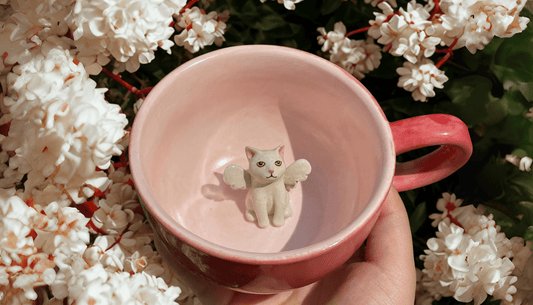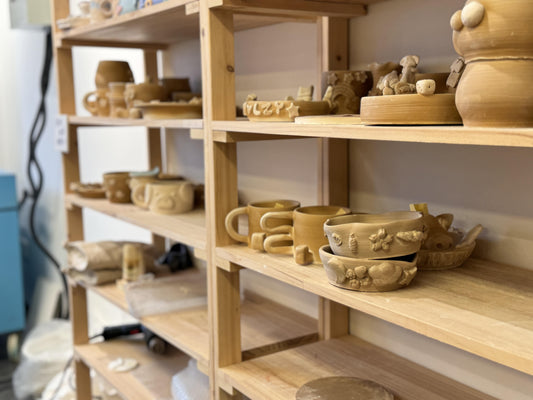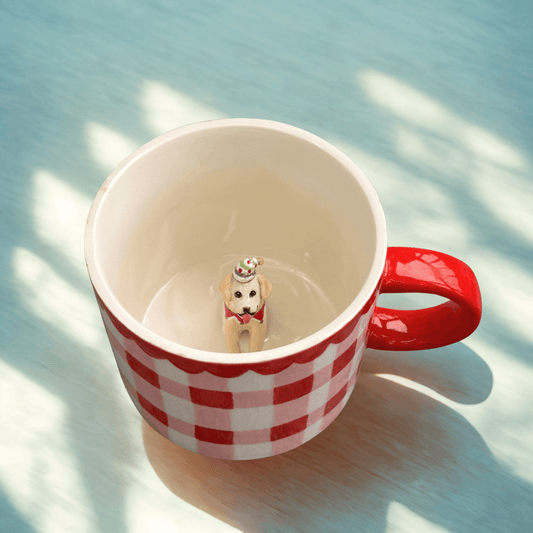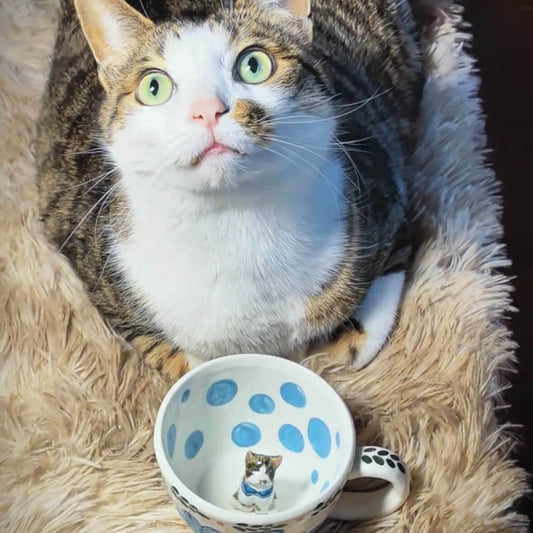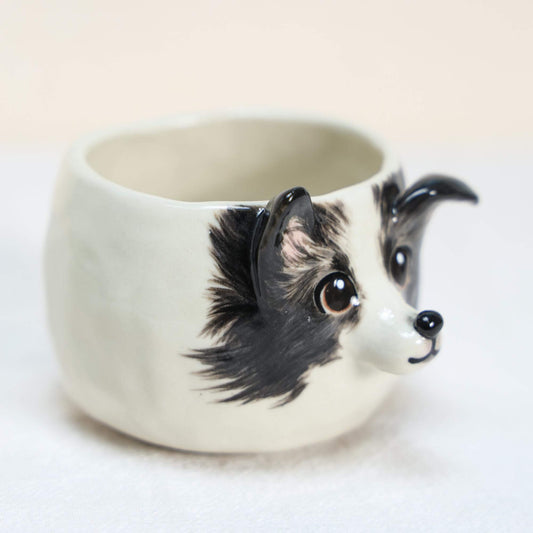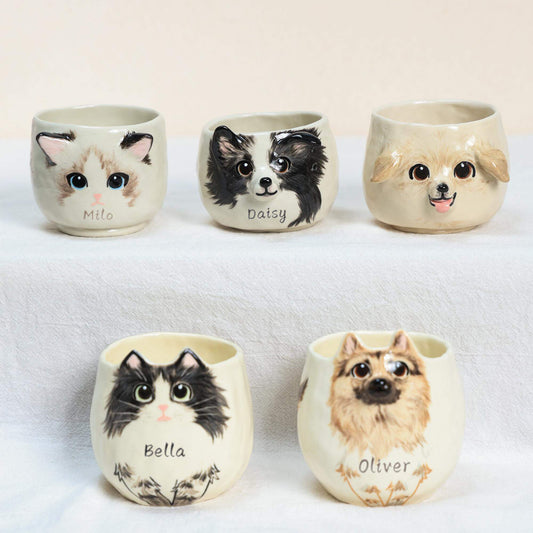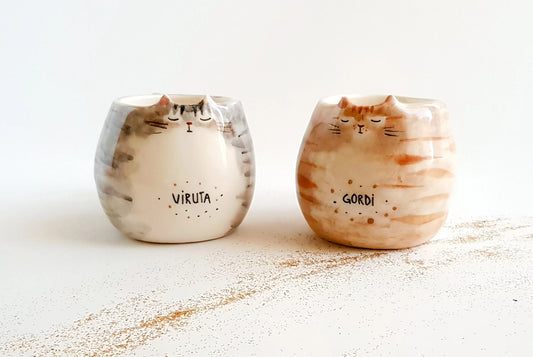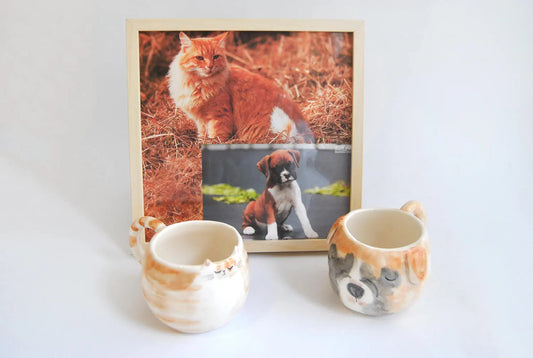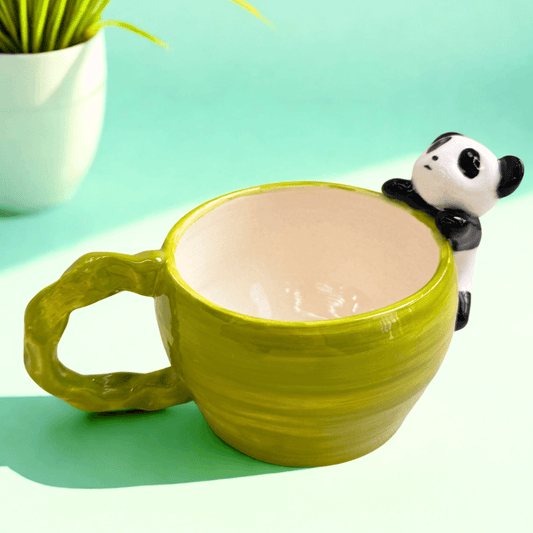
How Is the Glazing Process Done on Ceramic Mugs?
"Creativity is contagious, pass it on," Albert Einstein once said, and nowhere is this truer than in the world of handcrafted ceramics. The glazing process is the transformative stage where a simple ceramic coffee mug turns into a piece of art, brimming with color, texture, and unique character. If you've ever held a unique ceramic mug, you've felt the result of this meticulous art form that is both ancient and ever-evolving. Let's delve into how this magic happens, shall we?
Imagine the ceramic mug before you as a canvas, the glaze – a palette of minerals ready to tell a story. The glazing process is where your ceramic coffee mug begins to speak, where it gets its voice. A liquid suspension of finely ground minerals is skillfully applied to a bisque-fired ceramic ware. As it dries, the story is set, but it is only through the fiery dance within a kiln that these minerals melt and crystallize to form a glassy surface, making your ceramic mug not just waterproof and food-safe but also captivating to the eye.

The beauty of creating a unique ceramic mug lies in the intricate balance of glass-formers, fluxes, and stabilizers – each playing a pivotal role in the glaze's performance and appearance. Whether through dipping to coat evenly, brushing for personalized touches, or pouring to cover larger areas, every method speaks to the creator's intent and lends itself to a range of artistic expressions. Ultimately, it is the precise firing temperature that seals the fate of the glazing process, dictating whether your mug gleams with the sheen of a low-fire glaze or radiates the depth offered by mid-fire and high-fire alternatives.
Whether you're a connoisseur of ceramics or simply someone who appreciates the charm of a morning brew in a hand-glazed cup, understanding the glazing process elevates your appreciation for every sip. So, as you explore the journey from clay to a cherished ceramic coffee mug, remember, the essence of creativity is in the detail – and each unique ceramic mug has its own tale to tell.
Introduction to Ceramic Coffee Mug Glazing
Embarking on the journey of understanding the glazing process for ceramic drinkware opens up a world of creativity and technical prowess. Particularly, the process involved in crafting a ceramic mug is both an art and a science, aimed at enhancing both aesthetics and functionality. When you choose a piece from Boopcup, you're not just buying a mug; you're acquiring a piece of artisan craftsmanship that has undergone a thorough glazing process to ensure longevity and visual appeal.

The selection of the glaze is crucial, as it determines the final appearance and durability of the mug. Whether you prefer a glossy finish that catches the eye or a matte texture that speaks to understated elegance, understanding the properties of glazes can help you make more informed choices in your ceramic drinkware. Furthermore, brands like Boopcup put significant emphasis on ensuring that their products not only look great but also stand the test of time with their robust glazing applications.
This method involves applying a liquid suspension of minerals and colorants to the surface of bisque-fired ceramic ware. Once the ceramic mug undergoes subsequent firing, this layer vitrifies, turning into a glassy, impermeable coating that is both beautiful and functional. For many enthusiasts and everyday users alike, the allure of ceramic drinkware lies in this intricate yet essential process.
By choosing a glazed ceramic mug from Boopcup, you not only get a product that enhances your drinking experience but also one that contributes to a sustainable and artistic lifestyle. So next time you sip from your Boopcup mug, remember the meticulous steps involved in bringing such quality and character to your tabletop.
The Essential Components of Ceramic Glaze
The creation of the best ceramic mug begins at a microscopic level with the perfect blend of chemical components. These elements ensure the durability, functionality, and beauty of ceramic coffee mugs, especially when personalized. Understanding these materials will give you a deeper appreciation of your favorite ceramic drinkware.

Glass-Formers: The Backbone of Durability
At the heart of every quality ceramic glaze is the glass-former. Typically, silica is the key ingredient here, playing a pivotal role in forming the glassy surface that characterizes every ceramic coffee mug. This component not only contributes to the aesthetic appeal but significantly enhances the mug's longevity, making it suitable even for daily use.
Fluxes: Lowering the Firing Temperature
Fluxes are crucial for practical manufacturing processes, as they lower the melting point of silica, allowing the glaze to bond to the mug at lower temperatures. This not only makes the production of personalized ceramic mugs more energy-efficient but also preserves the integrity of delicate designs and colors often desired in personalized pieces.
Stabilizers: Ensuring Consistency and Strength
Stabilizers in ceramic glazes guarantee that your best ceramic mug maintains a uniform appearance with a strong bond to the ceramic body. They prevent the glaze from cracking or flaking, ensuring that the mug remains a reliable companion for your coffee rituals for years to come.
| Component | Role in Glaze | Impact on Mug Quality |
|---|---|---|
| Glass-Formers | Creates glass-like surface | Increases durability and visual appeal |
| Fluxes | Lowers firing temperature | Enhances energy efficiency and preserves designs |
| Stabilizers | Ensures even consistency | Prevents cracking, enhancing longevity |
Each ingredient in the glazing process plays a specific and critical role in crafting not just a functional ceramic coffee mug, but potentially the best ceramic mug that you can personalize and enjoy in your daily life. The precision in crafting these components directly influences the quality and uniqueness of the final product.
Diverse Glazing Techniques for Coffee Cups
The artistry behind creating the perfect coffee cup often lies in the practice of glazing. Different techniques are utilized to achieve various aesthetics and functionalities that turn an ordinary ceramic into a unique ceramic mug. Each method has its specific advantages, depending on the design goals and production needs.
Dipping: Achieving an Even Coat
Dipping is a preferred glazing technique for those producing a large volume of coffee cups. This method involves immersing the ceramic coffee cups into a glaze bath, ensuring a swift and uniform application. It's particularly effective for achieving consistent results across numerous pieces, making it a staple in commercial productions.
Brushing: For Detailed Work on Custom Ceramic Mugs
For artisans focusing on custom ceramic mugs, brushing is the go-to technique. This method allows for intricate patterns and specific color applications, highlighting the unique features of each mug. Brushing opens up endless possibilities for personalization, making each coffee cup a uniquely handcrafted piece.
Pouring: Covering Large Areas Efficiently
Pouring glaze over coffee cups is an efficient way to cover larger surface areas without the labor-intensive work of brushing. This technique is great for achieving a more fluid and organic finish, often desired in artistic and one-of-a-kind ceramic products. Pouring can also be creatively combined with other methods to enhance the uniqueness of each piece.
Whether dipping, brushing, or pouring, each method contributes distinctively to the allure and functionality of coffee cups. The choice of technique often reflects the aesthetic vision and practical requirements of the ceramist, underlining the custom nature of crafting unique ceramic mugs.
The Role of Kiln Firing in Ceramic Drinkware Finishing
Kiln firing plays a pivotal role in not only finalizing the aesthetic touch of your ceramic mug but also in enhancing its durability, making it the best ceramic mug for everyday enjoyment. Below, discover how different firing temperatures affect your ceramic coffee mug gift.
Understanding Low-Fire Glazes
Low-fire glazes, which are processed at temperatures around 1845 degrees Fahrenheit, are renowned for producing brilliant and vivid colors. These glazes are a perfect choice if you're seeking a ceramic mug with controlled hues that pop. Ideal for decorative pieces or a ceramic coffee mug gift, low-fire glazes also tend to have a glossier finish, adding a vibrant touch to your coffee rituals.
Exploring Mid-Fire and High-Fire Glazes
When kiln temperatures rise to 2192 degrees Fahrenheit for mid-fire glazes, you begin to see a subtle shift in color fidelity and texture, offering a more romantic visual effect that appeals to those who appreciate a rustic aesthetic. High-fire glazes go even further, reaching up to 2305 degrees Fahrenheit to create the most durable and vitreous surfaces. Despite a limited color range, the strength these glazes impart makes them a top choice for the best ceramic mug designed for extended use.
Crafting Unique Ceramic Mugs: From Matte to Glossy Finishes
When you choose a ceramic coffee mug, the finish is not just about aesthetics; it's about crafting a style that suits your taste. Whether you prefer the vibrant shine of glossy glazes or the refined sophistication of matte finishes, each type plays a crucial role in the design of handmade ceramic mugs.
Glossy glazes are perfect for those who love a bit of sparkle in their morning coffee routine. The shiny finish not only enhances the color depth of the ceramic coffee mug but also reflects light, making your mug a stand-out piece. It's ideal for anyone looking to add a touch of elegance to their daily coffee experience.
Glossy Glazes for a Shiny Finish
The appeal of glossy glazes lies in their ability to make colors pop and shine under any light. This kind of finish ensures that your unique ceramic mug catches the eye, boasting a surface that's as smooth as glass.
Matte and Satin Glazes for a Subtle Effect
On the other end of the spectrum, matte glazes offer a more understated elegance. Without the reflective sheen, these glazes bring out a softer, more textured look in the handmade ceramic mug, perfect for those who appreciate a minimalist design. Satin glazes, bridging the gap between matte and glossy, provide a low sheen that conveys sophistication without overpowering simplicity.
Each finish has its own beauty and character, impacting not only the look but also the feel of the mug in your hands. Whether purchasing a ceramic coffee mug for personal use or as a gift, understanding these finishes can help you select the perfect piece that truly reflects your personal style and enhances your coffee-drinking pleasure.
DIY Kiln Solutions for Handmade Ceramic Mug Enthusiasts
If you're keen on stepping into pottery, creating your handmade ceramic mug isn't just about shaping and painting; the firing process plays a crucial role in bringing your artwork to life. Fortunately, with DIY kiln solutions, you can achieve this right from the comfort of your home. For those who cherish unique and personalized ceramic mug designs, these methods provide a platform to express your creative flair.
Consider the following traditional and alternative firing methods that are perfect for ceramic mug enthusiasts:
- Pit Firing: This ancient technique involves burning your ceramic mugs in a pit filled with combustible materials. It's the most primal form of ceramic firing and gives your mugs unique, earthy tones that are unachievable with modern kilns.
- Barrel Kilns: Constructed from metal barrels, these are ideal for those looking to harness the simplicity of pit firing but with more control over the fire and temperature. They make an excellent choice for experimenting with reduction firing techniques.
- Raku Kilns: Although raku-fired mugs are generally not waterproof or safe for food, the process makes for incredibly dramatic and colorful glazes, perfect for decorative ceramic mugs.
Whichever method you choose, remember that each type of kiln offers a distinct texture and finish to your mugs, allowing you to put your personal stamp on every piece you create. Take the plunge and bring the timeless art of kiln firing into your crafting space; you might just discover a rewarding new aspect of working with ceramics.
The Future of Ceramic Mug Glazing: Innovations and Trends
As you gaze upon your morning's ceramic coffee mug, the comforting weight and warmth cradled in your hands are not just about the craftsmanship of today—they speak to a future rich with innovation and exciting possibilities. In the realm of unique ceramic mug creation, brands like Boopcup are at the forefront, infusing new life into the age-old tradition of ceramic glazing. They delve into a myriad of color palettes, experimenting with novel materials to produce glazes that are as functional as they are beautiful. Sometimes, these groundbreaking results spring from serendipitous accidents that occur during the creative process.
Looking ahead, the custom ceramic mug market is buzzing with activity, as artisans push the boundaries of both form and function. The latest trends hint at a sustainable approach, with eco-friendly materials playing a pivotal role in development. Moreover, technological advancements are transforming the way these mugs are produced—think 3D printing and digital glazing techniques which promise to open up a world of textured finishes and intricate patterns previously unimaginable.
Your appreciation for a unique ceramic mug goes beyond simple aesthetics; it's an anticipation for what's next in this dynamic field. The enduring allure of ceramic mug artistry ensures that your selection will continue to be diverse, blending traditional techniques with cutting-edge trends. Whether it's your everyday sipper or a custom ceramic mug tailored for that special someone, the future is poised to deliver an ever-widening array of drinking vessels that are as distinctive as they are durable.
### FAQ
#### Q: What is the process of glazing a ceramic mug?
A: The process of glazing a ceramic mug involves applying a liquid suspension of minerals, known as glaze, onto bisque-fired ceramic ware. Once applied, the mug is fired in a kiln, which melts the glaze into a glassy coating, enhancing the mug's aesthetic, strength, and making it waterproof and food-safe.
#### Q: How do the components of ceramic glaze affect the finished mug?
A: Ceramic glazes comprise glass-formers, fluxes, and stabilizers. Glass-formers create the glassy characteristic, fluxes lower the melting point for easier firing, and stabilizers maintain consistency and strength. These components are essential for achieving various finishes and durability in ceramic mugs.
#### Q: What are the main ingredients in a ceramic glaze?
A: The main ingredients in a ceramic glaze include glass-formers like silica, fluxes such as minerals that help lower the melting point, and stabilizers to enhance the bond to the clay body and maintain consistency in the glaze's application.
#### Q: What techniques are used to apply glaze to ceramic coffee cups?
A: Techniques for applying glaze to ceramic coffee cups include dipping for a uniform coat, brushing for detailed artwork, especially on custom or unique ceramic mugs, and pouring which is effective for covering large areas quickly.
#### Q: Can you explain the different kiln firing temperatures for ceramic glazes?
A: Kiln firing temperatures vary based on glaze classification. Low-fire glazes are fired at 1845°F and are known for their bright colors, mid-fire at 2192°F allowing for varied visual effects, and high-fire at 2305°F, making the strongest and most durable glazes with a more limited color range.
#### Q: What distinguishes glossy, matte, and satin glaze finishes on ceramic mugs?
A: Glossy glazes give a shiny, reflective finish that can intensify color depth, while matte glazes offer a non-reflective surface with subtle visual appeal. Satin glazes fall somewhere in between, providing a balance of shine and understated beauty.
#### Q: Are there DIY alternatives to traditional kiln firing for ceramic mugs?
A: Yes, DIY alternatives like pit firing, barrel kilns, and raku kilns exist for firing ceramic mugs. These methods enable enthusiasts to add personal touches to their mugs, though they may not always result in waterproof or food-safe pieces.
#### Q: What is the future of ceramic mug glazing techniques?
A: The future of ceramic mug glazing is promising with innovations in techniques and trends that combine aesthetic appeal and functionality. Brands are experimenting with new glaze materials and colors, catering to the demand for unique and custom ceramic mugs.

